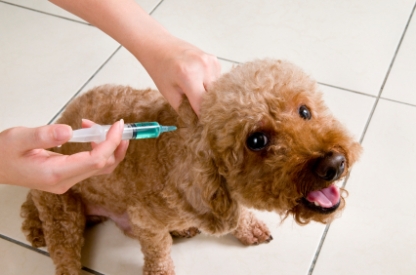Active prevention of diseases in dogs – tips and warnings
It’s no secret that dogs, like people who are at risk of contracting infectious diseases. Beloved pets await such a dangerous and common viral infections like enteritis, hepatitis, leptospirosis, plague and rabies. Reliable protection from these diseases – preventive vaccination.
The action is to develop a vaccine for dogs long active immunity. Vaccine should be distinguished from serum, which are intended for the treatment of infectious diseases, as initiated by passive immunity for a short time.
In order not to harm the poor pet vaccination, the vaccine must be purchased in pharmacies and clinics. Domestic and imported vaccines are available in two types: monovalent, containing a vaccine against the disease, and polyvalent – against a few at a time.
Despite the fact that in the first year of life the puppy will have to move 4.5 shots, first make better use of monovalent vaccine. They contribute to the development of a reliable immunity. To support the existing immunity of adult dogs suitable polyvalent vaccine.
Before the vaccine.
At the beginning of life the baby is protected by maternal immunity, which he was still in the embryonic period and then with colostrum. If the month puppy ate exclusively breast milk, and not go outside the apartment, in respect of infectious he is healthy. On the walk baby should be protected from dangerous contact with the environment and keep it on hand. This is extremely important, because you can only vaccinate healthy puppy.
Before you make a good shot to watch the appetite, stool, pet behavior. The temperature ranges from healthy dogs 38-39 degrees. Measure the temperature should be several times a day, not less than 15 minutes after waking up and eating. Such observations will help determine how well the dog suffered a vaccine.
Weakens the body is the presence of a puppy worms, they emit toxins inhibit the immune system. Therefore, prior to vaccination is important to get rid of parasites
When and how to vaccinate dogs.
The first preventive vaccine made against enteritis and hepatitis at the age of six weeks. Approximately two weeks later to repeat vaccination. The same amount of time necessary for sustainable production of immunity in dogs to these diseases for the year. Then, a repeat vaccination. Usually, puppies are easy to carry this vaccine.
No earlier than two and a half months of a puppy vaccinated against plague. Later, the vaccine is dangerous to do. After this vaccination complications are possible, so be a long quarantine period of three weeks, during which pet are immune to the plague. At this time the dog can not walk, run down, too cold, and wash.
When the puppy will grow all the permanent teeth, in about seven months old, vaccinated against distemper repeat. Then do it every year at the same time.
When the dog turns four months, you can vaccinate against leptospirosis. Puppies up to six months, the vaccine is administered again after six months if the dog is older, vaccination is repeated in a year.
Completes an annual list of vaccinations against rabies vaccinations. Allowed to make such a shot with a six-month old, but in practice often comes after eight months, when the booster will be held against the plague. Vaccination against rabies is carried by dogs is not easy. So within two weeks after vaccination is necessary to observe a strict quarantine.
Visit our Veterinary Supplies.
